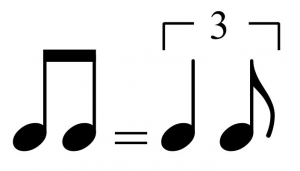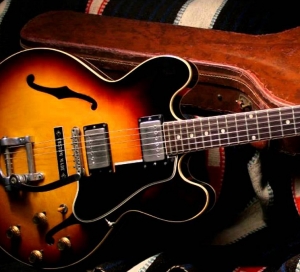In this lesson, we will go over a few basic things to get you started on your journey to play jazz guitar.
But before we get started, in order to save time, I’m going to ask that you do a bit of homework. This lesson will require you to know some very basic theory; rhythmic values, intervals, modes, triads, etc. This lesson will be a framework upon which to build for playing jazz guitar and requires some rudimentary knowledge of music theory.
Rhythm

One of the defining characteristics of jazz and many other genres is how it’s approached rhythmically. When playing jazz, accents are mostly on 2 and 4 in a 4/4 measure. The 8th notes are also swung. Let’s discuss what that means.
Swung 8th notes means playing regular 8th notes as in the diagram below:
This tends to apply most often at medium – medium swing tempos. If you listen to jazz recordings at higher tempos, the 8th notes begin to straighten out. It can sound pretty clunky trying to swing 8th notes at blazing tempos.
With regard to the accents on 2 and 4, a good way to start “feeling” this, is to take a metronome and try putting it at about 75 BPM or whatever feels comfortable for you, then try to feel each click as being beats 2 and 4.
Basic Triad and 7th Chord Construction
We will not really be able to move forward without covering some theory in this lesson. Let’s review basic triad construction.
Major = C(1) E(3) G(5)
Minor = C(1) Eb(b3) G(5)
Diminished = C(1) Eb(b3) Gb(b5)
Augmented = C(1) E(3) G#(#5)
It is important to make sure you have got this down to understand some of the basic 7th chords. Let’s move on. The basic 7th chords are listed below. Of course, there are alterations involved with these, particularly with the dominant chord, but we will keep it simple for now.
Major 7th = C(1) E(3) G(5) B(7)
Dominant 7th = C(1) E(3) G(5) Bb(b7)
Major 6th – C(1) E(3) G(5) A(6)
Minor 7th = C(1) Eb(b3) G(5) Bb(b7)
Minor 7b5 = C(1) Eb(b3) Gb(b5) Bb(b7)
Minor 6th = C(1) Eb(b3) G(5) A(6)
Diminished 7th = C(1) Eb(b3) Gb(b5) Bbb(bb7)
This is not a complete and comprehensive overview of 7th chords, but more of a starting point from which to build. I encourage you to explore the possibilities here.
Chord-Scale Relationships
Often, in popular music, the approach to soloing over a progression is to pick a key center and simply start blowing. This is totally valid and is even used in jazz from time to time. However, it is very important to learn how to treat each chord as its own sound in jazz. If you did your homework, you know the basic “church” modes of the major scale: Ionian, Dorian, Phrygian, Lydian, Mixolydian, Aeolian, and Locrian. For this lesson, we will focus on three that are commonly used in a basic ii V I progression.
Dorian (ii)

Mixolydian (V)

Ionian (I)

Or Lydian for the #11

Since we are discussing treating each chord as its own sound, you probably guessed that these are their respective relationships. This is only a very basic approach to this but it will get you started. I encourage you to take a look at a tune like “Autumn Leaves” and begin applying this stuff right away. You can find any number of backing tracks on YouTube and some of them even have charts for you right on the screen.
Guide Tones
Guide tones are the chord tones that give the chord its quality. In a basic 7th chord, they are the 3rds and the 7ths. I have provided a few simple guide tone “licks” to get you started on this concept. These licks make it a point to put the guide tones on strong beats. Make note of this concept, it’s universal among jazz players.
As with the previous example, I encourage you to take these licks and apply them to tunes right away. Many people think improvisation is the act of spontaneously coming up with brilliant musical material, but in reality, it is taking a bunch of smaller pre-worked concepts and combining them to make music in real time, much like speaking. It may feel unnatural at first when you are attempting to use this material while improvising, but over time, it will become part of your vocabulary. Think about a time when you first learned a new word and you tried to apply it. You might have felt like it was forced in the beginning, and then it felt natural. It works the same way with improvising.


Shell Voicings
Now let’s get to some basic chord shapes. These will get you by on just about any tune and you will probably find them useful even after years of playing. I know I have. These voicings omit the 5 as it tends to be a less important chord tone.
6th string:
Maj 7 –


Maj 6 –


Dom 7 –


Min 7 –


Min 7b5 –


Min 6 –


Dim 7 –


5th string:

Since we are omitting the 5, some of the shapes are the same because that is one of their defining qualities. When practicing these, it’s important to use good voice leading. Voice leading is basically the process of using closest possible notes when switching between chords. This makes for smooth progressions. Here are a few examples:
Pattern 1 –



Pattern 2 –



Once again, I encourage you to take these and apply them to tunes right away.
Tunes
I would be remiss if I didn’t suggest a few tunes for practice so here you go!
-Autumn Leaves
-So What
-Beautiful Love
-In A Sentimental Mood
-Little Sunflower
-Mr PC
About the Author
Marc-Andre Seguin is the webmaster, “brains behind” and teacher on JazzGuitarLessons.net, the #1 online resource for learning how to play jazz guitar. He draws from his experience both as a professional jazz guitarist and professional jazz teacher to help thousands of people from all around the world learn the craft of jazz guitar.




